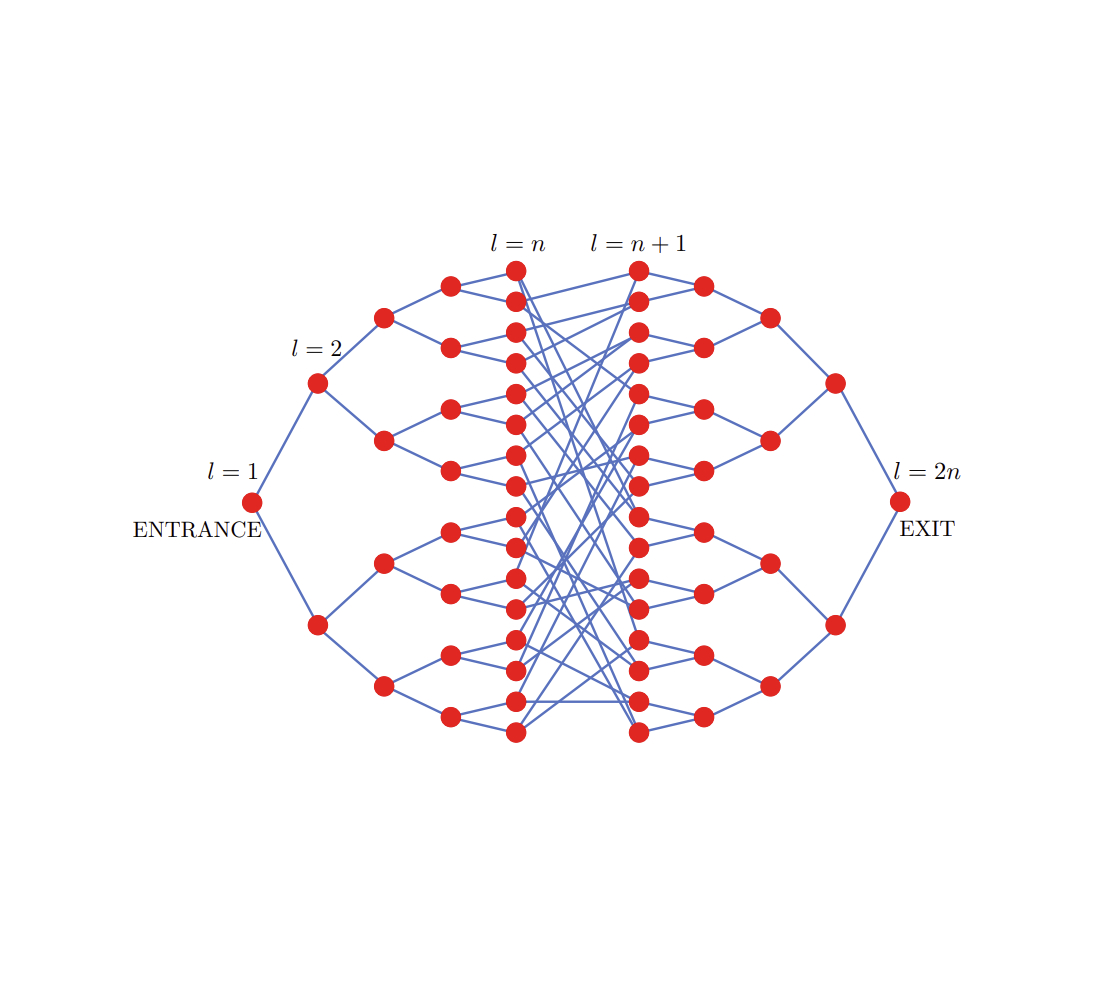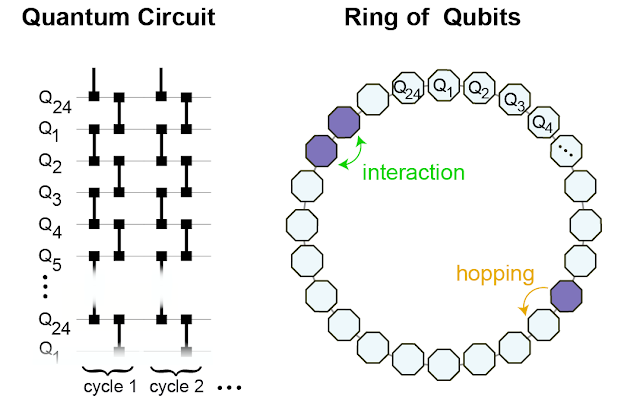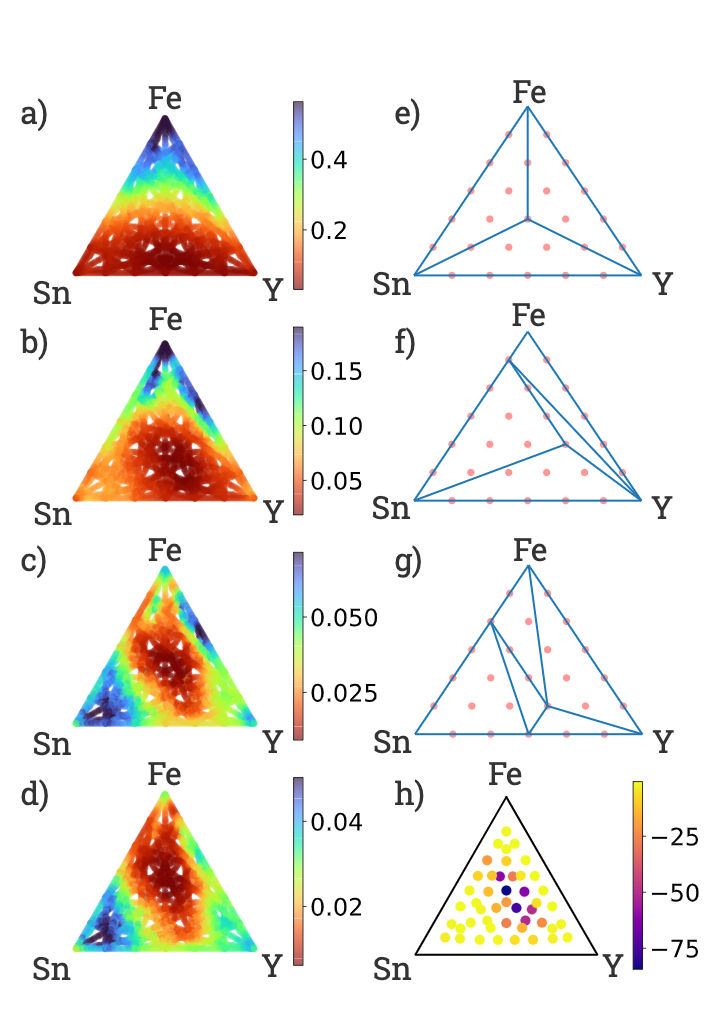Today the 2024 March Meeting of the American Physical Society (APS) kicks off in Minneapolis, MN. A premier conference on topics ranging across physics and related fields, APS 2024 brings together researchers, students, and industry professionals to share their discoveries and build partnerships with the goal of realizing fundamental advances in physics-related sciences and technology.
This year, Google has a strong presence at APS with a booth hosted by the Google Quantum AI team, 50+ talks throughout the conference, and participation in conference organizing activities, special sessions and events. Attending APS 2024 in person? Come visit Google’s Quantum AI booth to learn more about the exciting work we’re doing to solve some of the field’s most interesting challenges.
You can learn more about the latest cutting edge work we are presenting at the conference along with our schedule of booth events below (Googlers listed in bold).
Organizing Committee
Session Chairs include: Aaron Szasz
Booth Activities
This schedule is subject to change. Please visit the Google Quantum AI booth for more information.
Crumble
Presenter: Matt McEwen
Tue, Mar 5 | 11:00 AM CST
Qualtran
Presenter: Tanuj Khattar
Tue, Mar 5 | 2:30 PM CST
Qualtran
Presenter: Tanuj Khattar
Thu, Mar 7 | 11:00 AM CST
$5M XPRIZE / Google Quantum AI competition to accelerate quantum applications Q&A
Presenter: Ryan Babbush
Thu, Mar 7 | 11:00 AM CST
Talks
Monday
Certifying highly-entangled states from few single-qubit measurements
Presenter: Hsin-Yuan Huang
Author: Hsin-Yuan Huang
Session A45: New Frontiers in Machine Learning Quantum Physics
Toward high-fidelity analog quantum simulation with superconducting qubits
Presenter: Trond Andersen
Authors: Trond I Andersen, Xiao Mi, Amir H Karamlou, Nikita Astrakhantsev, Andrey Klots, Julia Berndtsson, Andre Petukhov, Dmitry Abanin, Lev B Ioffe, Yu Chen, Vadim Smelyanskiy, Pedram Roushan
Session A51: Applications on Noisy Quantum Hardware I
Measuring circuit errors in context for surface code circuits
Presenter: Dripto M Debroy
Authors: Dripto M Debroy, Jonathan A Gross, Élie Genois, Zhang Jiang
Session B50: Characterizing Noise with QCVV Techniques
Quantum computation of stopping power for inertial fusion target design I: Physics overview and the limits of classical algorithms
Presenter: Andrew D. Baczewski
Authors: Nicholas C. Rubin, Dominic W. Berry, Alina Kononov, Fionn D. Malone, Tanuj Khattar, Alec White, Joonho Lee, Hartmut Neven, Ryan Babbush, Andrew D. Baczewski
Session B51: Heterogeneous Design for Quantum Applications
Link to Paper
Quantum computation of stopping power for inertial fusion target design II: Physics overview and the limits of classical algorithms
Presenter: Nicholas C. Rubin
Authors: Nicholas C. Rubin, Dominic W. Berry, Alina Kononov, Fionn D. Malone, Tanuj Khattar, Alec White, Joonho Lee, Hartmut Neven, Ryan Babbush, Andrew D. Baczewski
Session B51: Heterogeneous Design for Quantum Applications
Link to Paper
Calibrating Superconducting Qubits: From NISQ to Fault Tolerance
Presenter: Sabrina S Hong
Author: Sabrina S Hong
Session B56: From NISQ to Fault Tolerance
Measurement and feedforward induced entanglement negativity transition
Presenter: Ramis Movassagh
Authors: Alireza Seif, Yu-Xin Wang, Ramis Movassagh, Aashish A. Clerk
Session B31: Measurement Induced Criticality in Many-Body Systems
Link to Paper
Effective quantum volume, fidelity and computational cost of noisy quantum processing experiments
Presenter: Salvatore Mandra
Authors: Kostyantyn Kechedzhi, Sergei V Isakov, Salvatore Mandra, Benjamin Villalonga, X. Mi, Sergio Boixo, Vadim Smelyanskiy
Session B52: Quantum Algorithms and Complexity
Link to Paper
Accurate thermodynamic tables for solids using Machine Learning Interaction Potentials and Covariance of Atomic Positions
Presenter: Mgcini K Phuthi
Authors: Mgcini K Phuthi, Yang Huang, Michael Widom, Ekin D Cubuk, Venkat Viswanathan
Session D60: Machine Learning of Molecules and Materials: Chemical Space and Dynamics
Tuesday
IN-Situ Pulse Envelope Characterization Technique (INSPECT)
Presenter: Zhang Jiang
Authors: Zhang Jiang, Jonathan A Gross, Élie Genois
Session F50: Advanced Randomized Benchmarking and Gate Calibration
Characterizing two-qubit gates with dynamical decoupling
Presenter: Jonathan A Gross
Authors: Jonathan A Gross, Zhang Jiang, Élie Genois, Dripto M Debroy, Ze-Pei Cian*, Wojciech Mruczkiewicz
Session F50: Advanced Randomized Benchmarking and Gate Calibration
Statistical physics of regression with quadratic models
Presenter: Blake Bordelon
Authors: Blake Bordelon, Cengiz Pehlevan, Yasaman Bahri
Session EE01: V: Statistical and Nonlinear Physics II
Improved state preparation for first-quantized simulation of electronic structure
Presenter: William J Huggins
Authors: William J Huggins, Oskar Leimkuhler, Torin F Stetina, Birgitta Whaley
Session G51: Hamiltonian Simulation
Controlling large superconducting quantum processors
Presenter: Paul V. Klimov
Authors: Paul V. Klimov, Andreas Bengtsson, Chris Quintana, Alexandre Bourassa, Sabrina Hong, Andrew Dunsworth, Kevin J. Satzinger, William P. Livingston, Volodymyr Sivak, Murphy Y. Niu, Trond I. Andersen, Yaxing Zhang, Desmond Chik, Zijun Chen, Charles Neill, Catherine Erickson, Alejandro Grajales Dau, Anthony Megrant, Pedram Roushan, Alexander N. Korotkov, Julian Kelly, Vadim Smelyanskiy, Yu Chen, Hartmut Neven
Session G30: Commercial Applications of Quantum Computing)
Link to Paper
Gaussian boson sampling: Determining quantum advantage
Presenter: Peter D Drummond
Authors: Peter D Drummond, Alex Dellios, Ned Goodman, Margaret D Reid, Ben Villalonga
Session G50: Quantum Characterization, Verification, and Validation II
Attention to complexity III: learning the complexity of random quantum circuit states
Presenter: Hyejin Kim
Authors: Hyejin Kim, Yiqing Zhou, Yichen Xu, Chao Wan, Jin Zhou, Yuri D Lensky, Jesse Hoke, Pedram Roushan, Kilian Q Weinberger, Eun-Ah Kim
Session G50: Quantum Characterization, Verification, and Validation II
Balanced coupling in superconducting circuits
Presenter: Daniel T Sank
Authors: Daniel T Sank, Sergei V Isakov, Mostafa Khezri, Juan Atalaya
Session K48: Strongly Driven Superconducting Systems
Resource estimation of Fault Tolerant algorithms using Qᴜᴀʟᴛʀᴀɴ
Presenter: Tanuj Khattar
Author: Tanuj Khattar
Session K49: Algorithms and Implementations on Near-Term Quantum Computers
Wednesday
Discovering novel quantum dynamics with superconducting qubits
Presenter: Pedram Roushan
Author: Pedram Roushan
Session M24: Analog Quantum Simulations Across Platforms
Deciphering Tumor Heterogeneity in Triple-Negative Breast Cancer: The Crucial Role of Dynamic Cell-Cell and Cell-Matrix Interactions
Presenter: Susan Leggett
Authors: Susan Leggett, Ian Wong, Celeste Nelson, Molly Brennan, Mohak Patel, Christian Franck, Sophia Martinez, Joe Tien, Lena Gamboa, Thomas Valentin, Amanda Khoo, Evelyn K Williams
Session M27: Mechanics of Cells and Tissues II
Toward implementation of protected charge-parity qubits
Presenter: Abigail Shearrow
Authors: Abigail Shearrow, Matthew Snyder, Bradley G Cole, Kenneth R Dodge, Yebin Liu, Andrey Klots, Lev B Ioffe, Britton L Plourde, Robert McDermott
Session N48: Unconventional Superconducting Qubits
Electronic capacitance in tunnel junctions for protected charge-parity qubits
Presenter: Bradley G Cole
Authors: Bradley G Cole, Kenneth R Dodge, Yebin Liu, Abigail Shearrow, Matthew Snyder, Andrey Klots, Lev B Ioffe, Robert McDermott, B.L.T. Plourde
Session N48: Unconventional Superconducting Qubits
Overcoming leakage in quantum error correction
Presenter: Kevin C. Miao
Authors: Kevin C. Miao, Matt McEwen, Juan Atalaya, Dvir Kafri, Leonid P. Pryadko, Andreas Bengtsson, Alex Opremcak, Kevin J. Satzinger, Zijun Chen, Paul V. Klimov, Chris Quintana, Rajeev Acharya, Kyle Anderson, Markus Ansmann, Frank Arute, Kunal Arya, Abraham Asfaw, Joseph C. Bardin, Alexandre Bourassa, Jenna Bovaird, Leon Brill, Bob B. Buckley, David A. Buell, Tim Burger, Brian Burkett, Nicholas Bushnell, Juan Campero, Ben Chiaro, Roberto Collins, Paul Conner, Alexander L. Crook, Ben Curtin, Dripto M. Debroy, Sean Demura, Andrew Dunsworth, Catherine Erickson, Reza Fatemi, Vinicius S. Ferreira, Leslie Flores Burgos, Ebrahim Forati, Austin G. Fowler, Brooks Foxen, Gonzalo Garcia, William Giang, Craig Gidney, Marissa Giustina, Raja Gosula, Alejandro Grajales Dau, Jonathan A. Gross, Michael C. Hamilton, Sean D. Harrington, Paula Heu, Jeremy Hilton, Markus R. Hoffmann, Sabrina Hong, Trent Huang, Ashley Huff, Justin Iveland, Evan Jeffrey, Zhang Jiang, Cody Jones, Julian Kelly, Seon Kim, Fedor Kostritsa, John Mark Kreikebaum, David Landhuis, Pavel Laptev, Lily Laws, Kenny Lee, Brian J. Lester, Alexander T. Lill, Wayne Liu, Aditya Locharla, Erik Lucero, Steven Martin, Anthony Megrant, Xiao Mi, Shirin Montazeri, Alexis Morvan, Ofer Naaman, Matthew Neeley, Charles Neill, Ani Nersisyan, Michael Newman, Jiun How Ng, Anthony Nguyen, Murray Nguyen, Rebecca Potter, Charles Rocque, Pedram Roushan, Kannan Sankaragomathi, Christopher Schuster, Michael J. Shearn, Aaron Shorter, Noah Shutty, Vladimir Shvarts, Jindra Skruzny, W. Clarke Smith, George Sterling, Marco Szalay, Douglas Thor, Alfredo Torres, Theodore White, Bryan W. K. Woo, Z. Jamie Yao, Ping Yeh, Juhwan Yoo, Grayson Young, Adam Zalcman, Ningfeng Zhu, Nicholas Zobrist, Hartmut Neven, Vadim Smelyanskiy, Andre Petukhov, Alexander N. Korotkov, Daniel Sank, Yu Chen
Session N51: Quantum Error Correction Code Performance and Implementation I
Link to Paper
Modeling the performance of the surface code with non-uniform error distribution: Part 1
Presenter: Yuri D Lensky
Authors: Yuri D Lensky, Volodymyr Sivak, Kostyantyn Kechedzhi, Igor Aleiner
Session N51: Quantum Error Correction Code Performance and Implementation I
Modeling the performance of the surface code with non-uniform error distribution: Part 2
Presenter: Volodymyr Sivak
Authors: Volodymyr Sivak, Michael Newman, Cody Jones, Henry Schurkus, Dvir Kafri, Yuri D Lensky, Paul Klimov, Kostyantyn Kechedzhi, Vadim Smelyanskiy
Session N51: Quantum Error Correction Code Performance and Implementation I
Highly optimized tensor network contractions for the simulation of classically challenging quantum computations
Presenter: Benjamin Villalonga
Author: Benjamin Villalonga
Session Q51: Co-evolution of Quantum Classical Algorithms
Teaching modern quantum computing concepts using hands-on open-source software at all levels
Presenter: Abraham Asfaw
Author: Abraham Asfaw
Session Q61: Teaching Quantum Information at All Levels II
Thursday
New circuits and an open source decoder for the color code
Presenter: Craig Gidney
Authors: Craig Gidney, Cody Jones
Session S51: Quantum Error Correction Code Performance and Implementation II
Link to Paper
Performing Hartree-Fock many-body physics calculations with large language models
Presenter: Eun-Ah Kim
Authors: Eun-Ah Kim, Haining Pan, Nayantara Mudur, William Taranto, Subhashini Venugopalan, Yasaman Bahri, Michael P Brenner
Session S18: Data Science, AI and Machine Learning in Physics I
New methods for reducing resource overhead in the surface code
Presenter: Michael Newman
Authors: Craig M Gidney, Michael Newman, Peter Brooks, Cody Jones
Session S51: Quantum Error Correction Code Performance and Implementation II
Link to Paper
Challenges and opportunities for applying quantum computers to drug design
Presenter: Raffaele Santagati
Authors: Raffaele Santagati, Alan Aspuru-Guzik, Ryan Babbush, Matthias Degroote, Leticia Gonzalez, Elica Kyoseva, Nikolaj Moll, Markus Oppel, Robert M. Parrish, Nicholas C. Rubin, Michael Streif, Christofer S. Tautermann, Horst Weiss, Nathan Wiebe, Clemens Utschig-Utschig
Session S49: Advances in Quantum Algorithms for Near-Term Applications
Link to Paper
Dispatches from Google's hunt for super-quadratic quantum advantage in new applications
Presenter: Ryan Babbush
Author: Ryan Babbush
Session T45: Recent Advances in Quantum Algorithms
Qubit as a reflectometer
Presenter: Yaxing Zhang
Authors: Yaxing Zhang, Benjamin Chiaro
Session T48: Superconducting Fabrication, Packaging, & Validation
Random-matrix theory of measurement-induced phase transitions in nonlocal Floquet quantum circuits
Presenter: Aleksei Khindanov
Authors: Aleksei Khindanov, Lara Faoro, Lev Ioffe, Igor Aleiner
Session W14: Measurement-Induced Phase Transitions
Continuum limit of finite density many-body ground states with MERA
Presenter: Subhayan Sahu
Authors: Subhayan Sahu, Guifré Vidal
Session W58: Extreme-Scale Computational Science Discovery in Fluid Dynamics and Related Disciplines II
Dynamics of magnetization at infinite temperature in a Heisenberg spin chain
Presenter: Eliott Rosenberg
Authors: Eliott Rosenberg, Trond Andersen, Rhine Samajdar, Andre Petukhov, Jesse Hoke*, Dmitry Abanin, Andreas Bengtsson, Ilya Drozdov, Catherine Erickson, Paul Klimov, Xiao Mi, Alexis Morvan, Matthew Neeley, Charles Neill, Rajeev Acharya, Richard Allen, Kyle Anderson, Markus Ansmann, Frank Arute, Kunal Arya, Abraham Asfaw, Juan Atalaya, Joseph Bardin, A. Bilmes, Gina Bortoli, Alexandre Bourassa, Jenna Bovaird, Leon Brill, Michael Broughton, Bob B. Buckley, David Buell, Tim Burger, Brian Burkett, Nicholas Bushnell, Juan Campero, Hung-Shen Chang, Zijun Chen, Benjamin Chiaro, Desmond Chik, Josh Cogan, Roberto Collins, Paul Conner, William Courtney, Alexander Crook, Ben Curtin, Dripto Debroy, Alexander Del Toro Barba, Sean Demura, Agustin Di Paolo, Andrew Dunsworth, Clint Earle, E. Farhi, Reza Fatemi, Vinicius Ferreira, Leslie Flores, Ebrahim Forati, Austin Fowler, Brooks Foxen, Gonzalo Garcia, Élie Genois, William Giang, Craig Gidney, Dar Gilboa, Marissa Giustina, Raja Gosula, Alejandro Grajales Dau, Jonathan Gross, Steve Habegger, Michael Hamilton, Monica Hansen, Matthew Harrigan, Sean Harrington, Paula Heu, Gordon Hill, Markus Hoffmann, Sabrina Hong, Trent Huang, Ashley Huff, William Huggins, Lev Ioffe, Sergei Isakov, Justin Iveland, Evan Jeffrey, Zhang Jiang, Cody Jones, Pavol Juhas, D. Kafri, Tanuj Khattar, Mostafa Khezri, Mária Kieferová, Seon Kim, Alexei Kitaev, Andrey Klots, Alexander Korotkov, Fedor Kostritsa, John Mark Kreikebaum, David Landhuis, Pavel Laptev, Kim Ming Lau, Lily Laws, Joonho Lee, Kenneth Lee, Yuri Lensky, Brian Lester, Alexander Lill, Wayne Liu, William P. Livingston, A. Locharla, Salvatore Mandrà, Orion Martin, Steven Martin, Jarrod McClean, Matthew McEwen, Seneca Meeks, Kevin Miao, Amanda Mieszala, Shirin Montazeri, Ramis Movassagh, Wojciech Mruczkiewicz, Ani Nersisyan, Michael Newman, Jiun How Ng, Anthony Nguyen, Murray Nguyen, M. Niu, Thomas O'Brien, Seun Omonije, Alex Opremcak, Rebecca Potter, Leonid Pryadko, Chris Quintana, David Rhodes, Charles Rocque, N. Rubin, Negar Saei, Daniel Sank, Kannan Sankaragomathi, Kevin Satzinger, Henry Schurkus, Christopher Schuster, Michael Shearn, Aaron Shorter, Noah Shutty, Vladimir Shvarts, Volodymyr Sivak, Jindra Skruzny, Clarke Smith, Rolando Somma, George Sterling, Doug Strain, Marco Szalay, Douglas Thor, Alfredo Torres, Guifre Vidal, Benjamin Villalonga, Catherine Vollgraff Heidweiller, Theodore White, Bryan Woo, Cheng Xing, Jamie Yao, Ping Yeh, Juhwan Yoo, Grayson Young, Adam Zalcman, Yaxing Zhang, Ningfeng Zhu, Nicholas Zobrist, Hartmut Neven, Ryan Babbush, Dave Bacon, Sergio Boixo, Jeremy Hilton, Erik Lucero, Anthony Megrant, Julian Kelly, Yu Chen, Vadim Smelyanskiy, Vedika Khemani, Sarang Gopalakrishnan, Tomaž Prosen, Pedram Roushan
Session W50: Quantum Simulation of Many-Body Physics
Link to Paper
The fast multipole method on a quantum computer
Presenter: Kianna Wan
Authors: Kianna Wan, Dominic W Berry, Ryan Babbush
Session W50: Quantum Simulation of Many-Body Physics
Friday
The quantum computing industry and protecting national security: what tools will work?
Presenter: Kate Weber
Author: Kate Weber
Session Y43: Industry, Innovation, and National Security: Finding the Right Balance
Novel charging effects in the fluxonium qubit
Presenter: Agustin Di Paolo
Authors: Agustin Di Paolo, Kyle Serniak, Andrew J Kerman, William D Oliver
Session Y46: Fluxonium-Based Superconducting Quibits
Microwave Engineering of Parametric Interactions in Superconducting Circuits
Presenter: Ofer Naaman
Author: Ofer Naaman
Session Z46: Broadband Parametric Amplifiers and Circulators
Linear spin wave theory of large magnetic unit cells using the Kernel Polynomial Method
Presenter: Harry Lane
Authors: Harry Lane, Hao Zhang, David A Dahlbom, Sam Quinn, Rolando D Somma, Martin P Mourigal, Cristian D Batista, Kipton Barros
Session Z62: Cooperative Phenomena, Theory
*Work done while at Google
































